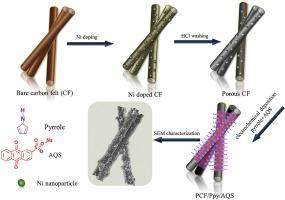International Journal of Hydrogen Energy ( IF 8.1 ) Pub Date : 2020-05-23 , DOI: 10.1016/j.ijhydene.2020.04.197 Ying Gao , Weihuang Zhu , Yaqi Li , Junli Li , Sining Yun , Tinglin Huang

|
A novelty two-step synthesized porous carbon felt (PCF) cathode modified by cyclic voltammetric (CV) electrodeposited polypyrrole (Ppy) and anthraquinone 2-sulfonate (AQS) (PCF/Ppy/AQS) for an efficient electro-Fenton process has been investigated. Brunauer Emmett Teller (BET) and scanning electron microscope (SEM) measurements verified the three-dimensional porous structure of the PCF, revealing that the specific surface area was approximately 2.5 times higher than that of the bare carbon felt (CF), which ensured more active sites available for oxygen reduction reaction (ORR). In addition, the electrodeposited Ppy decreases the charge transfer resistance (Rct) of the PCF cathode. AQS, a type of anthraquinone that can serve as an oxygen reduction catalyzer, could accelerate the ORR process and subsequently improve the performance of the electro-Fenton system. Rotating disk electrode (RDE) analysis confirmed that the ORR catalyzed by AQS was a double-electron reduction process, which contributed to hydrogen peroxide (H2O2) generation. The removal efficiency of total organic carbon (TOC) from Rhodamine B (RhB) could reach 51% within 1 h in the electro-Fenton system equipped with the PCF/Ppy/AQS, resulting in an improvement of approximately 24% compared with the bare CF cathode without porous treatment. The cycle experiment showed a good stability of the PCF/Ppy/AQS cathode. Additionally, the possible mechanism of degradation process in the electro-Fenton equipped with the PCF/Ppy/AQS cathode was proposed based on the electron paramagnetic resonance (EPR) analysis and quenching experiment. The novel fabricated PCF/Ppy/AQS provides an alternative as a high-efficiency cathode, yielding energy savings in the electro-Fenton system.
中文翻译:

循环伏安电沉积聚吡咯和2-磺酸蒽醌修饰的新型多孔碳毡阴极,用于高效电芬顿工艺
研究了一种新颖的两步合成多孔碳毡(PCF)阴极,该阴极经循环伏安(CV)电沉积的聚吡咯(Ppy)和蒽醌2-磺酸盐(AQS)(PCF / Ppy / AQS)改性,用于高效的电子芬顿工艺。Brunauer Emmett Teller(BET)和扫描电子显微镜(SEM)测量验证了PCF的三维多孔结构,显示比表面积约为裸碳毡(CF)的2.5倍,从而确保了更大的比表面积。可用于氧还原反应(ORR)的活性位点。此外,电沉积的Ppy降低了电荷转移电阻(R ct)的PCF阴极。AQS是一种可以用作氧还原催化剂的蒽醌,它可以加快ORR过程并随后改善电子芬顿系统的性能。旋转圆盘电极(RDE)分析证实,AQS催化的ORR是双电子还原过程,这导致了过氧化氢(H 2 O 2) 一代。配备PCF / Ppy / AQS的电子芬顿系统在1小时内从若丹明B(RhB)中去除总有机碳(TOC)的效率可以达到51%,与裸露的相比,提高了约24% CF阴极未经多孔处理。循环实验表明PCF / Ppy / AQS阴极具有良好的稳定性。此外,基于电子顺磁共振(EPR)分析和猝灭实验,提出了配备PCF / Ppy / AQS阴极的电子芬顿体系中降解过程的可能机理。新型制成的PCF / Ppy / AQS提供了一种替代方案,可作为高效阴极,从而在电子芬顿系统中节省了能源。











































 京公网安备 11010802027423号
京公网安备 11010802027423号